Unit 15: Managing Business Activities to Achieve Results - A Report
VerifiedAdded on 2024/05/21
|13
|4120
|498
Report
AI Summary
This report focuses on managing business activities to achieve results, using Nissan Motor Company as a case study. It highlights key functions and processes within Nissan, including production, marketing, HR, and finance, emphasizing their interrelation. The 5W1H technique is discussed as a methodology for business process mapping. The purpose of a quality gateway in Nissan's operations department is examined, focusing on identifying errors early in the process. The report also applies Management by Objectives (MBO), setting SMART objectives related to production capacity, cost reduction, and quality improvement. Furthermore, it suggests standard systems for monitoring and controlling operations, such as quality teams and checklists, and explores the implementation of a quality culture within Nissan. Finally, the report addresses risk assessments and health and safety regulations applicable to Nissan's work environment.
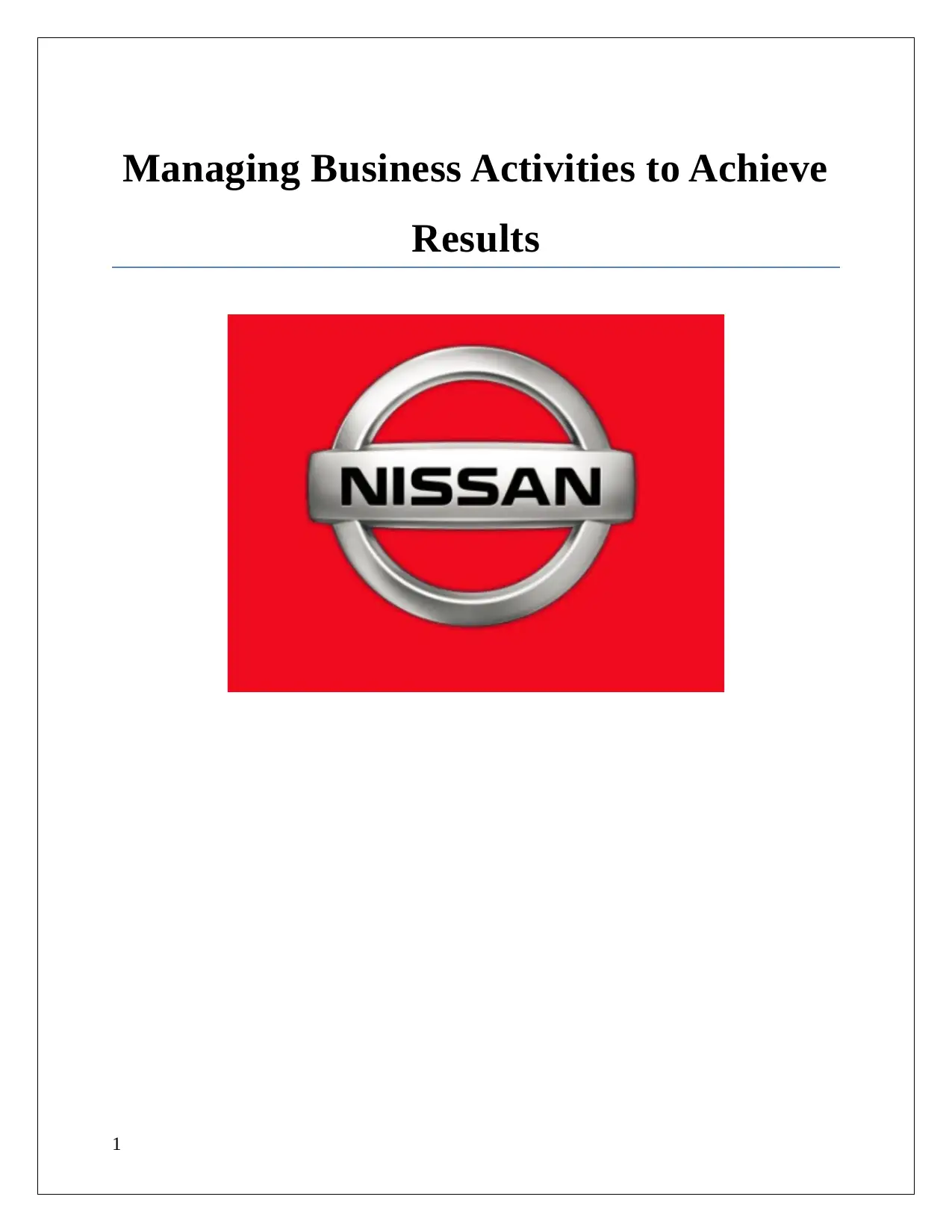
Managing Business Activities to Achieve
Results
1
Results
1
Paraphrase This Document
Need a fresh take? Get an instant paraphrase of this document with our AI Paraphraser
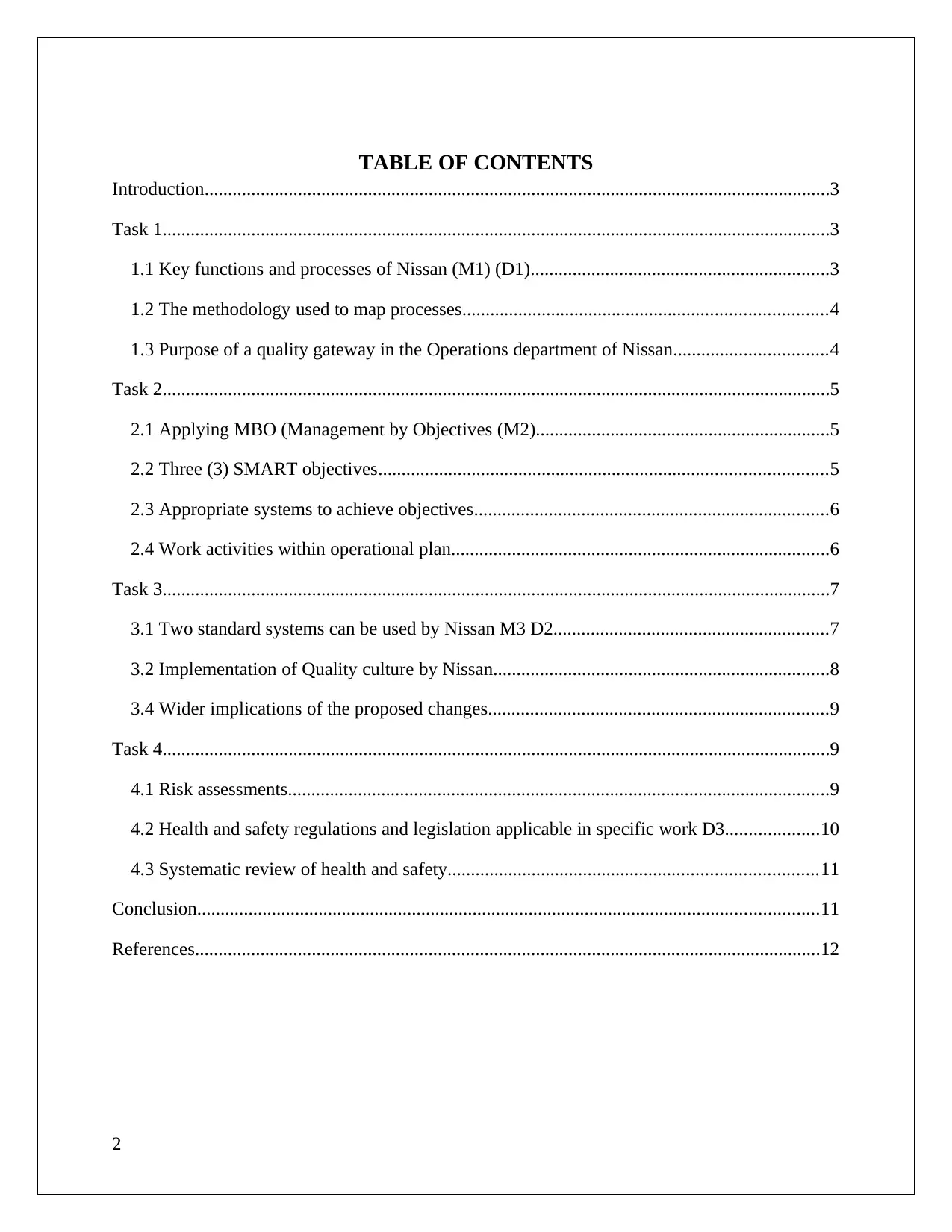
TABLE OF CONTENTS
Introduction......................................................................................................................................3
Task 1...............................................................................................................................................3
1.1 Key functions and processes of Nissan (M1) (D1)................................................................3
1.2 The methodology used to map processes..............................................................................4
1.3 Purpose of a quality gateway in the Operations department of Nissan.................................4
Task 2...............................................................................................................................................5
2.1 Applying MBO (Management by Objectives (M2)...............................................................5
2.2 Three (3) SMART objectives................................................................................................5
2.3 Appropriate systems to achieve objectives............................................................................6
2.4 Work activities within operational plan.................................................................................6
Task 3...............................................................................................................................................7
3.1 Two standard systems can be used by Nissan M3 D2...........................................................7
3.2 Implementation of Quality culture by Nissan........................................................................8
3.4 Wider implications of the proposed changes.........................................................................9
Task 4...............................................................................................................................................9
4.1 Risk assessments....................................................................................................................9
4.2 Health and safety regulations and legislation applicable in specific work D3....................10
4.3 Systematic review of health and safety...............................................................................11
Conclusion.....................................................................................................................................11
References......................................................................................................................................12
2
Introduction......................................................................................................................................3
Task 1...............................................................................................................................................3
1.1 Key functions and processes of Nissan (M1) (D1)................................................................3
1.2 The methodology used to map processes..............................................................................4
1.3 Purpose of a quality gateway in the Operations department of Nissan.................................4
Task 2...............................................................................................................................................5
2.1 Applying MBO (Management by Objectives (M2)...............................................................5
2.2 Three (3) SMART objectives................................................................................................5
2.3 Appropriate systems to achieve objectives............................................................................6
2.4 Work activities within operational plan.................................................................................6
Task 3...............................................................................................................................................7
3.1 Two standard systems can be used by Nissan M3 D2...........................................................7
3.2 Implementation of Quality culture by Nissan........................................................................8
3.4 Wider implications of the proposed changes.........................................................................9
Task 4...............................................................................................................................................9
4.1 Risk assessments....................................................................................................................9
4.2 Health and safety regulations and legislation applicable in specific work D3....................10
4.3 Systematic review of health and safety...............................................................................11
Conclusion.....................................................................................................................................11
References......................................................................................................................................12
2
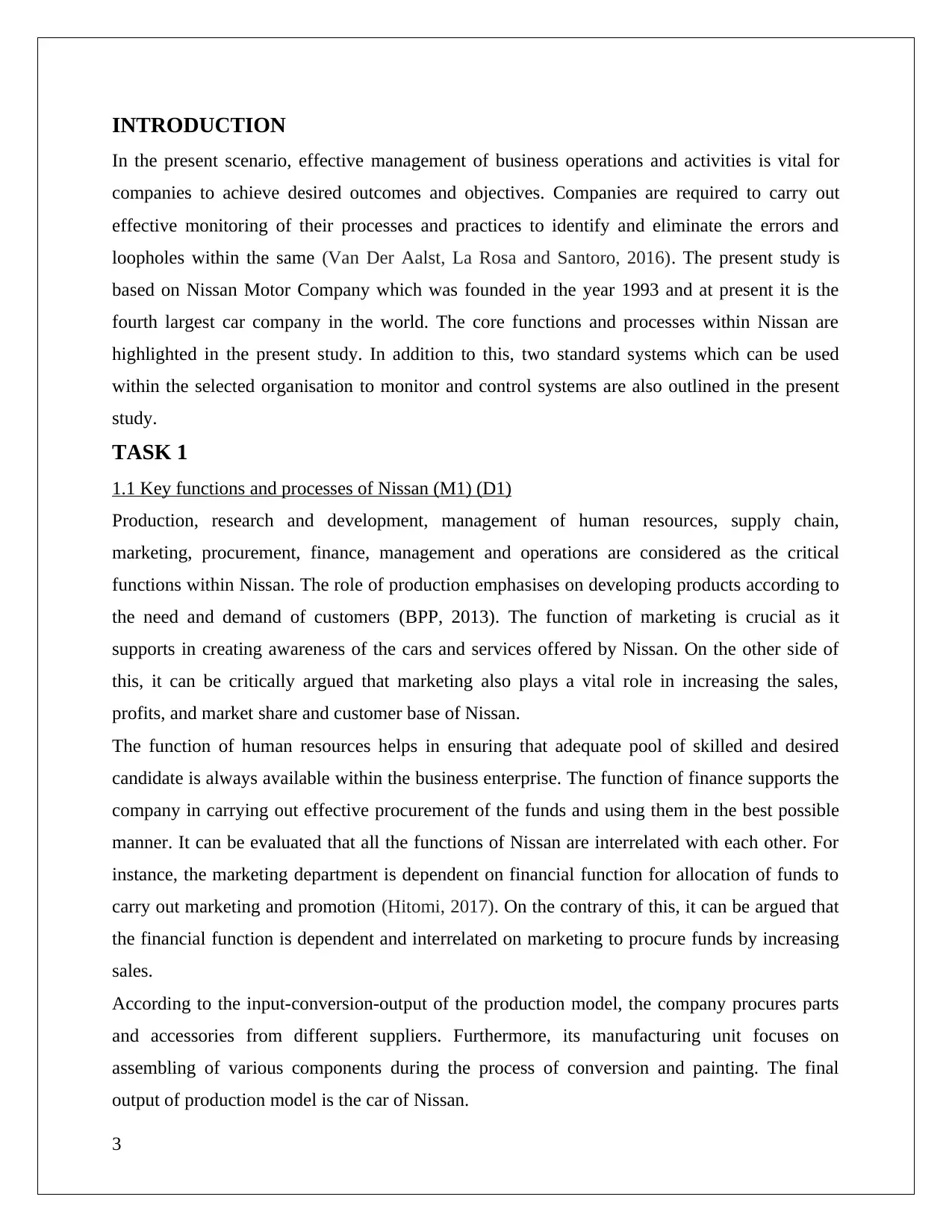
INTRODUCTION
In the present scenario, effective management of business operations and activities is vital for
companies to achieve desired outcomes and objectives. Companies are required to carry out
effective monitoring of their processes and practices to identify and eliminate the errors and
loopholes within the same (Van Der Aalst, La Rosa and Santoro, 2016). The present study is
based on Nissan Motor Company which was founded in the year 1993 and at present it is the
fourth largest car company in the world. The core functions and processes within Nissan are
highlighted in the present study. In addition to this, two standard systems which can be used
within the selected organisation to monitor and control systems are also outlined in the present
study.
TASK 1
1.1 Key functions and processes of Nissan (M1) (D1)
Production, research and development, management of human resources, supply chain,
marketing, procurement, finance, management and operations are considered as the critical
functions within Nissan. The role of production emphasises on developing products according to
the need and demand of customers (BPP, 2013). The function of marketing is crucial as it
supports in creating awareness of the cars and services offered by Nissan. On the other side of
this, it can be critically argued that marketing also plays a vital role in increasing the sales,
profits, and market share and customer base of Nissan.
The function of human resources helps in ensuring that adequate pool of skilled and desired
candidate is always available within the business enterprise. The function of finance supports the
company in carrying out effective procurement of the funds and using them in the best possible
manner. It can be evaluated that all the functions of Nissan are interrelated with each other. For
instance, the marketing department is dependent on financial function for allocation of funds to
carry out marketing and promotion (Hitomi, 2017). On the contrary of this, it can be argued that
the financial function is dependent and interrelated on marketing to procure funds by increasing
sales.
According to the input-conversion-output of the production model, the company procures parts
and accessories from different suppliers. Furthermore, its manufacturing unit focuses on
assembling of various components during the process of conversion and painting. The final
output of production model is the car of Nissan.
3
In the present scenario, effective management of business operations and activities is vital for
companies to achieve desired outcomes and objectives. Companies are required to carry out
effective monitoring of their processes and practices to identify and eliminate the errors and
loopholes within the same (Van Der Aalst, La Rosa and Santoro, 2016). The present study is
based on Nissan Motor Company which was founded in the year 1993 and at present it is the
fourth largest car company in the world. The core functions and processes within Nissan are
highlighted in the present study. In addition to this, two standard systems which can be used
within the selected organisation to monitor and control systems are also outlined in the present
study.
TASK 1
1.1 Key functions and processes of Nissan (M1) (D1)
Production, research and development, management of human resources, supply chain,
marketing, procurement, finance, management and operations are considered as the critical
functions within Nissan. The role of production emphasises on developing products according to
the need and demand of customers (BPP, 2013). The function of marketing is crucial as it
supports in creating awareness of the cars and services offered by Nissan. On the other side of
this, it can be critically argued that marketing also plays a vital role in increasing the sales,
profits, and market share and customer base of Nissan.
The function of human resources helps in ensuring that adequate pool of skilled and desired
candidate is always available within the business enterprise. The function of finance supports the
company in carrying out effective procurement of the funds and using them in the best possible
manner. It can be evaluated that all the functions of Nissan are interrelated with each other. For
instance, the marketing department is dependent on financial function for allocation of funds to
carry out marketing and promotion (Hitomi, 2017). On the contrary of this, it can be argued that
the financial function is dependent and interrelated on marketing to procure funds by increasing
sales.
According to the input-conversion-output of the production model, the company procures parts
and accessories from different suppliers. Furthermore, its manufacturing unit focuses on
assembling of various components during the process of conversion and painting. The final
output of production model is the car of Nissan.
3
⊘ This is a preview!⊘
Do you want full access?
Subscribe today to unlock all pages.

Trusted by 1+ million students worldwide
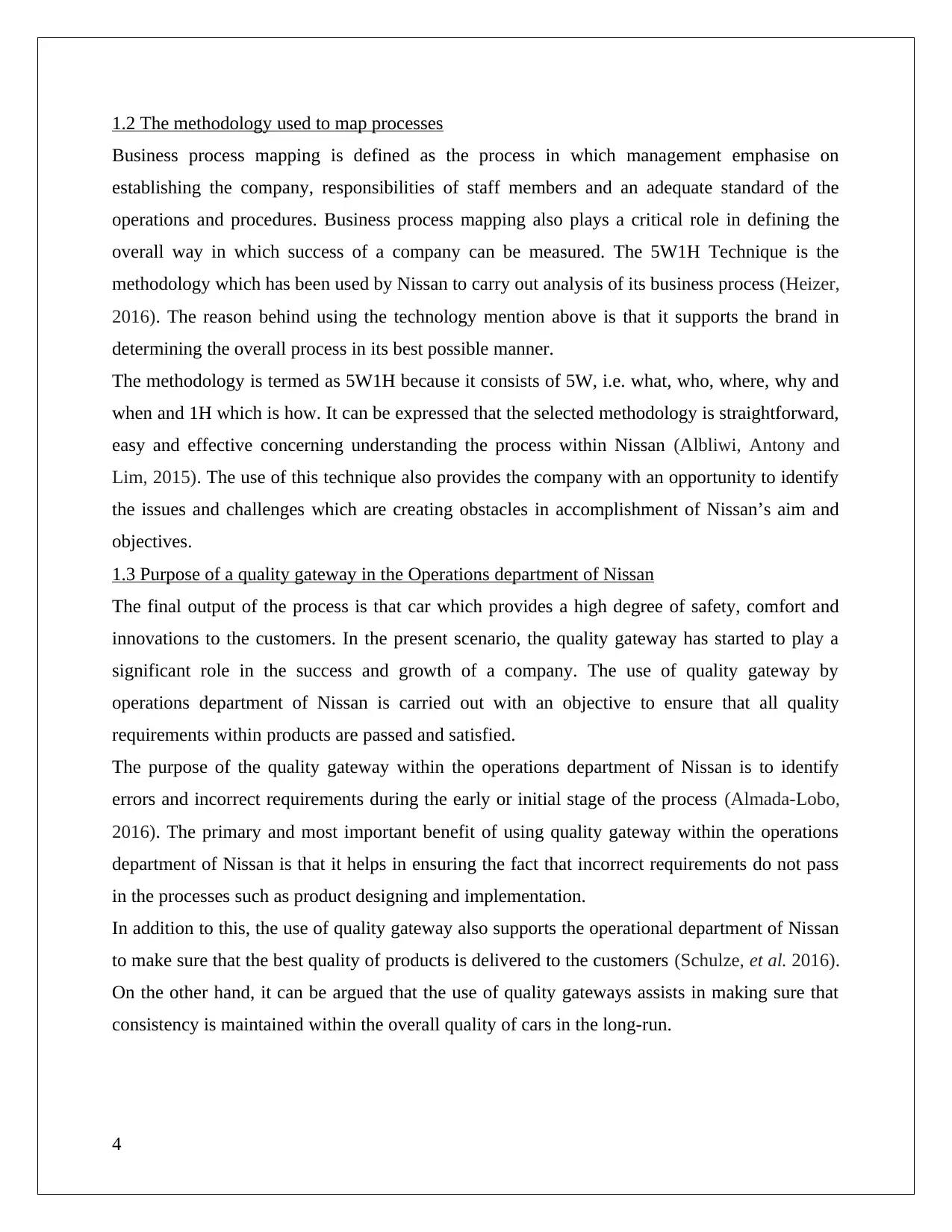
1.2 The methodology used to map processes
Business process mapping is defined as the process in which management emphasise on
establishing the company, responsibilities of staff members and an adequate standard of the
operations and procedures. Business process mapping also plays a critical role in defining the
overall way in which success of a company can be measured. The 5W1H Technique is the
methodology which has been used by Nissan to carry out analysis of its business process (Heizer,
2016). The reason behind using the technology mention above is that it supports the brand in
determining the overall process in its best possible manner.
The methodology is termed as 5W1H because it consists of 5W, i.e. what, who, where, why and
when and 1H which is how. It can be expressed that the selected methodology is straightforward,
easy and effective concerning understanding the process within Nissan (Albliwi, Antony and
Lim, 2015). The use of this technique also provides the company with an opportunity to identify
the issues and challenges which are creating obstacles in accomplishment of Nissan’s aim and
objectives.
1.3 Purpose of a quality gateway in the Operations department of Nissan
The final output of the process is that car which provides a high degree of safety, comfort and
innovations to the customers. In the present scenario, the quality gateway has started to play a
significant role in the success and growth of a company. The use of quality gateway by
operations department of Nissan is carried out with an objective to ensure that all quality
requirements within products are passed and satisfied.
The purpose of the quality gateway within the operations department of Nissan is to identify
errors and incorrect requirements during the early or initial stage of the process (Almada-Lobo,
2016). The primary and most important benefit of using quality gateway within the operations
department of Nissan is that it helps in ensuring the fact that incorrect requirements do not pass
in the processes such as product designing and implementation.
In addition to this, the use of quality gateway also supports the operational department of Nissan
to make sure that the best quality of products is delivered to the customers (Schulze, et al. 2016).
On the other hand, it can be argued that the use of quality gateways assists in making sure that
consistency is maintained within the overall quality of cars in the long-run.
4
Business process mapping is defined as the process in which management emphasise on
establishing the company, responsibilities of staff members and an adequate standard of the
operations and procedures. Business process mapping also plays a critical role in defining the
overall way in which success of a company can be measured. The 5W1H Technique is the
methodology which has been used by Nissan to carry out analysis of its business process (Heizer,
2016). The reason behind using the technology mention above is that it supports the brand in
determining the overall process in its best possible manner.
The methodology is termed as 5W1H because it consists of 5W, i.e. what, who, where, why and
when and 1H which is how. It can be expressed that the selected methodology is straightforward,
easy and effective concerning understanding the process within Nissan (Albliwi, Antony and
Lim, 2015). The use of this technique also provides the company with an opportunity to identify
the issues and challenges which are creating obstacles in accomplishment of Nissan’s aim and
objectives.
1.3 Purpose of a quality gateway in the Operations department of Nissan
The final output of the process is that car which provides a high degree of safety, comfort and
innovations to the customers. In the present scenario, the quality gateway has started to play a
significant role in the success and growth of a company. The use of quality gateway by
operations department of Nissan is carried out with an objective to ensure that all quality
requirements within products are passed and satisfied.
The purpose of the quality gateway within the operations department of Nissan is to identify
errors and incorrect requirements during the early or initial stage of the process (Almada-Lobo,
2016). The primary and most important benefit of using quality gateway within the operations
department of Nissan is that it helps in ensuring the fact that incorrect requirements do not pass
in the processes such as product designing and implementation.
In addition to this, the use of quality gateway also supports the operational department of Nissan
to make sure that the best quality of products is delivered to the customers (Schulze, et al. 2016).
On the other hand, it can be argued that the use of quality gateways assists in making sure that
consistency is maintained within the overall quality of cars in the long-run.
4
Paraphrase This Document
Need a fresh take? Get an instant paraphrase of this document with our AI Paraphraser
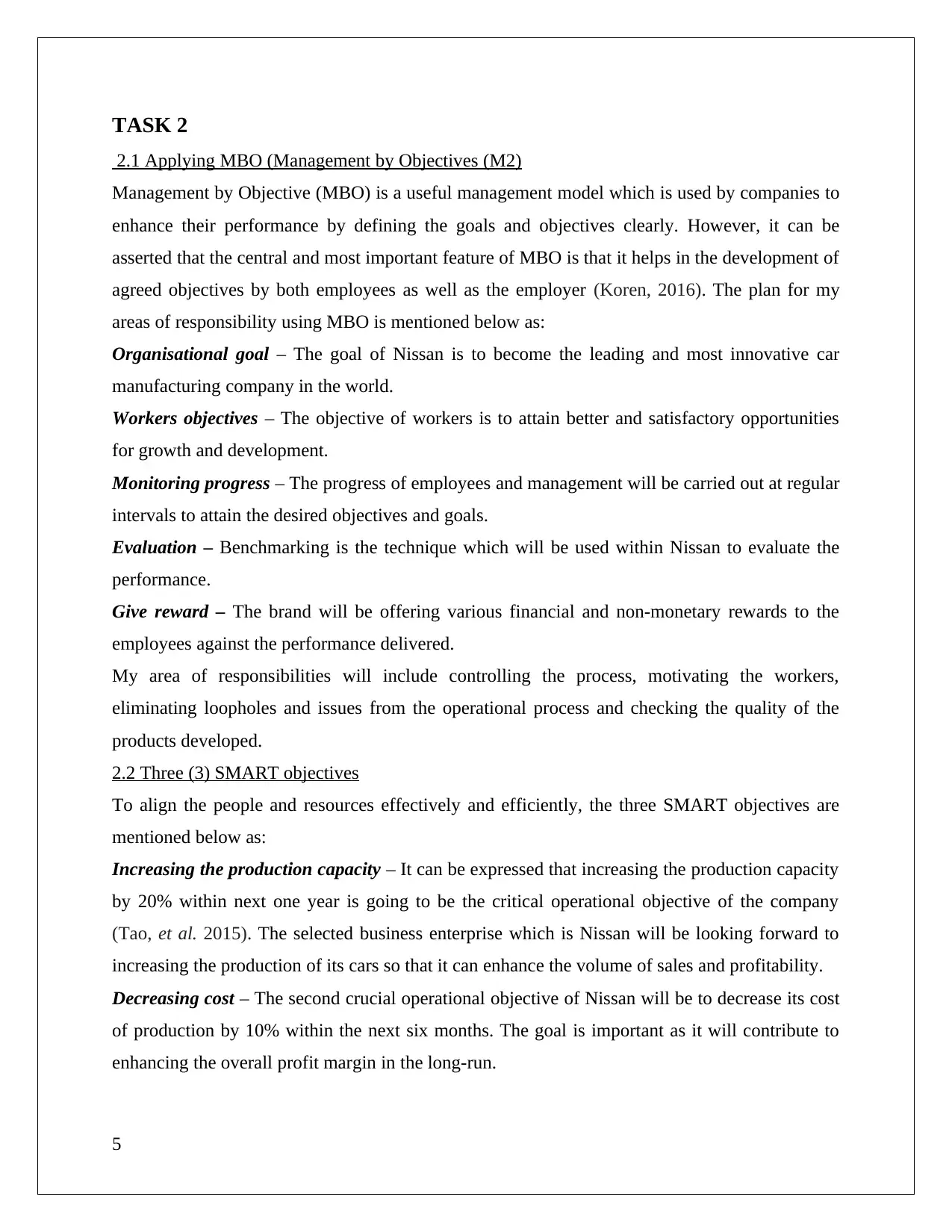
TASK 2
2.1 Applying MBO (Management by Objectives (M2)
Management by Objective (MBO) is a useful management model which is used by companies to
enhance their performance by defining the goals and objectives clearly. However, it can be
asserted that the central and most important feature of MBO is that it helps in the development of
agreed objectives by both employees as well as the employer (Koren, 2016). The plan for my
areas of responsibility using MBO is mentioned below as:
Organisational goal – The goal of Nissan is to become the leading and most innovative car
manufacturing company in the world.
Workers objectives – The objective of workers is to attain better and satisfactory opportunities
for growth and development.
Monitoring progress – The progress of employees and management will be carried out at regular
intervals to attain the desired objectives and goals.
Evaluation – Benchmarking is the technique which will be used within Nissan to evaluate the
performance.
Give reward – The brand will be offering various financial and non-monetary rewards to the
employees against the performance delivered.
My area of responsibilities will include controlling the process, motivating the workers,
eliminating loopholes and issues from the operational process and checking the quality of the
products developed.
2.2 Three (3) SMART objectives
To align the people and resources effectively and efficiently, the three SMART objectives are
mentioned below as:
Increasing the production capacity – It can be expressed that increasing the production capacity
by 20% within next one year is going to be the critical operational objective of the company
(Tao, et al. 2015). The selected business enterprise which is Nissan will be looking forward to
increasing the production of its cars so that it can enhance the volume of sales and profitability.
Decreasing cost – The second crucial operational objective of Nissan will be to decrease its cost
of production by 10% within the next six months. The goal is important as it will contribute to
enhancing the overall profit margin in the long-run.
5
2.1 Applying MBO (Management by Objectives (M2)
Management by Objective (MBO) is a useful management model which is used by companies to
enhance their performance by defining the goals and objectives clearly. However, it can be
asserted that the central and most important feature of MBO is that it helps in the development of
agreed objectives by both employees as well as the employer (Koren, 2016). The plan for my
areas of responsibility using MBO is mentioned below as:
Organisational goal – The goal of Nissan is to become the leading and most innovative car
manufacturing company in the world.
Workers objectives – The objective of workers is to attain better and satisfactory opportunities
for growth and development.
Monitoring progress – The progress of employees and management will be carried out at regular
intervals to attain the desired objectives and goals.
Evaluation – Benchmarking is the technique which will be used within Nissan to evaluate the
performance.
Give reward – The brand will be offering various financial and non-monetary rewards to the
employees against the performance delivered.
My area of responsibilities will include controlling the process, motivating the workers,
eliminating loopholes and issues from the operational process and checking the quality of the
products developed.
2.2 Three (3) SMART objectives
To align the people and resources effectively and efficiently, the three SMART objectives are
mentioned below as:
Increasing the production capacity – It can be expressed that increasing the production capacity
by 20% within next one year is going to be the critical operational objective of the company
(Tao, et al. 2015). The selected business enterprise which is Nissan will be looking forward to
increasing the production of its cars so that it can enhance the volume of sales and profitability.
Decreasing cost – The second crucial operational objective of Nissan will be to decrease its cost
of production by 10% within the next six months. The goal is important as it will contribute to
enhancing the overall profit margin in the long-run.
5
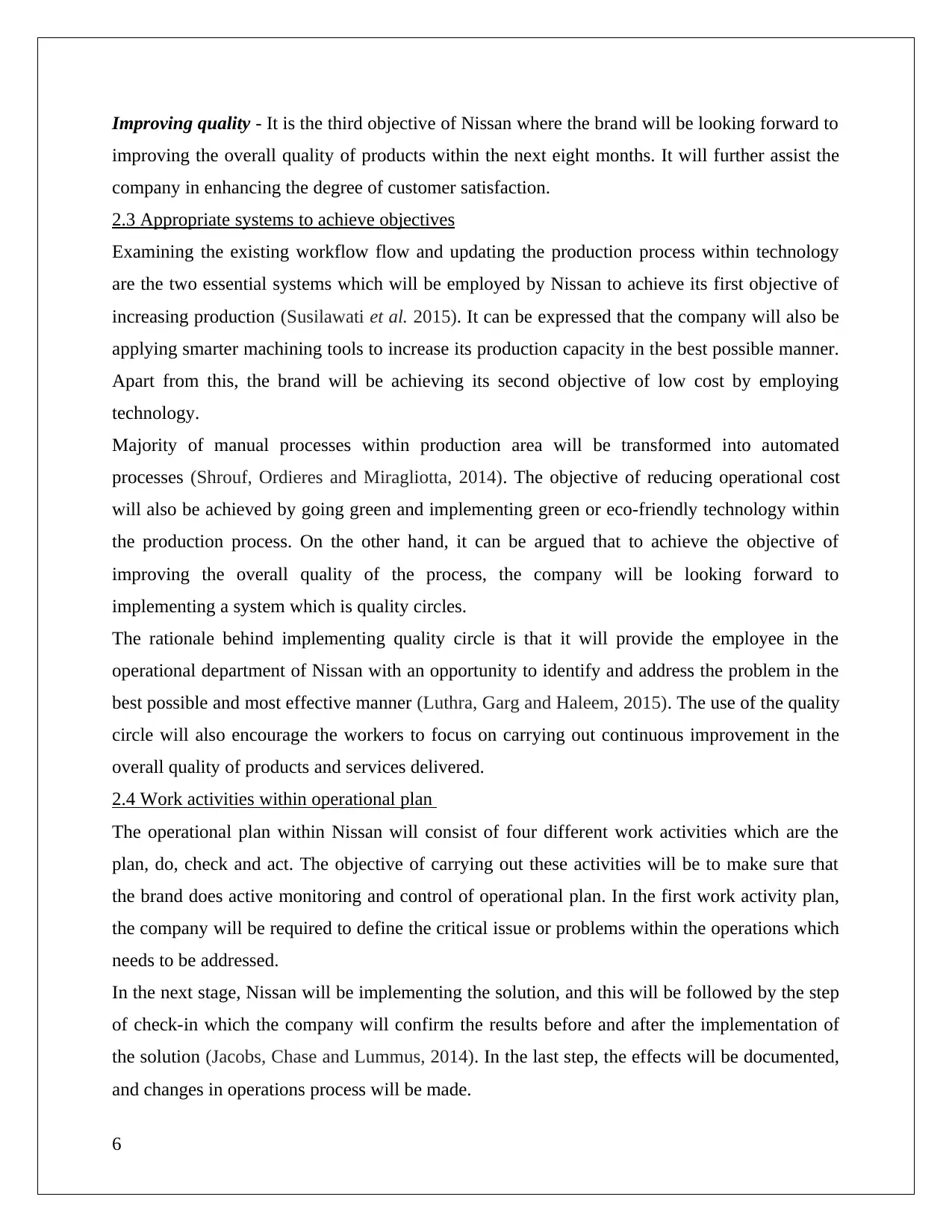
Improving quality - It is the third objective of Nissan where the brand will be looking forward to
improving the overall quality of products within the next eight months. It will further assist the
company in enhancing the degree of customer satisfaction.
2.3 Appropriate systems to achieve objectives
Examining the existing workflow flow and updating the production process within technology
are the two essential systems which will be employed by Nissan to achieve its first objective of
increasing production (Susilawati et al. 2015). It can be expressed that the company will also be
applying smarter machining tools to increase its production capacity in the best possible manner.
Apart from this, the brand will be achieving its second objective of low cost by employing
technology.
Majority of manual processes within production area will be transformed into automated
processes (Shrouf, Ordieres and Miragliotta, 2014). The objective of reducing operational cost
will also be achieved by going green and implementing green or eco-friendly technology within
the production process. On the other hand, it can be argued that to achieve the objective of
improving the overall quality of the process, the company will be looking forward to
implementing a system which is quality circles.
The rationale behind implementing quality circle is that it will provide the employee in the
operational department of Nissan with an opportunity to identify and address the problem in the
best possible and most effective manner (Luthra, Garg and Haleem, 2015). The use of the quality
circle will also encourage the workers to focus on carrying out continuous improvement in the
overall quality of products and services delivered.
2.4 Work activities within operational plan
The operational plan within Nissan will consist of four different work activities which are the
plan, do, check and act. The objective of carrying out these activities will be to make sure that
the brand does active monitoring and control of operational plan. In the first work activity plan,
the company will be required to define the critical issue or problems within the operations which
needs to be addressed.
In the next stage, Nissan will be implementing the solution, and this will be followed by the step
of check-in which the company will confirm the results before and after the implementation of
the solution (Jacobs, Chase and Lummus, 2014). In the last step, the effects will be documented,
and changes in operations process will be made.
6
improving the overall quality of products within the next eight months. It will further assist the
company in enhancing the degree of customer satisfaction.
2.3 Appropriate systems to achieve objectives
Examining the existing workflow flow and updating the production process within technology
are the two essential systems which will be employed by Nissan to achieve its first objective of
increasing production (Susilawati et al. 2015). It can be expressed that the company will also be
applying smarter machining tools to increase its production capacity in the best possible manner.
Apart from this, the brand will be achieving its second objective of low cost by employing
technology.
Majority of manual processes within production area will be transformed into automated
processes (Shrouf, Ordieres and Miragliotta, 2014). The objective of reducing operational cost
will also be achieved by going green and implementing green or eco-friendly technology within
the production process. On the other hand, it can be argued that to achieve the objective of
improving the overall quality of the process, the company will be looking forward to
implementing a system which is quality circles.
The rationale behind implementing quality circle is that it will provide the employee in the
operational department of Nissan with an opportunity to identify and address the problem in the
best possible and most effective manner (Luthra, Garg and Haleem, 2015). The use of the quality
circle will also encourage the workers to focus on carrying out continuous improvement in the
overall quality of products and services delivered.
2.4 Work activities within operational plan
The operational plan within Nissan will consist of four different work activities which are the
plan, do, check and act. The objective of carrying out these activities will be to make sure that
the brand does active monitoring and control of operational plan. In the first work activity plan,
the company will be required to define the critical issue or problems within the operations which
needs to be addressed.
In the next stage, Nissan will be implementing the solution, and this will be followed by the step
of check-in which the company will confirm the results before and after the implementation of
the solution (Jacobs, Chase and Lummus, 2014). In the last step, the effects will be documented,
and changes in operations process will be made.
6
⊘ This is a preview!⊘
Do you want full access?
Subscribe today to unlock all pages.

Trusted by 1+ million students worldwide
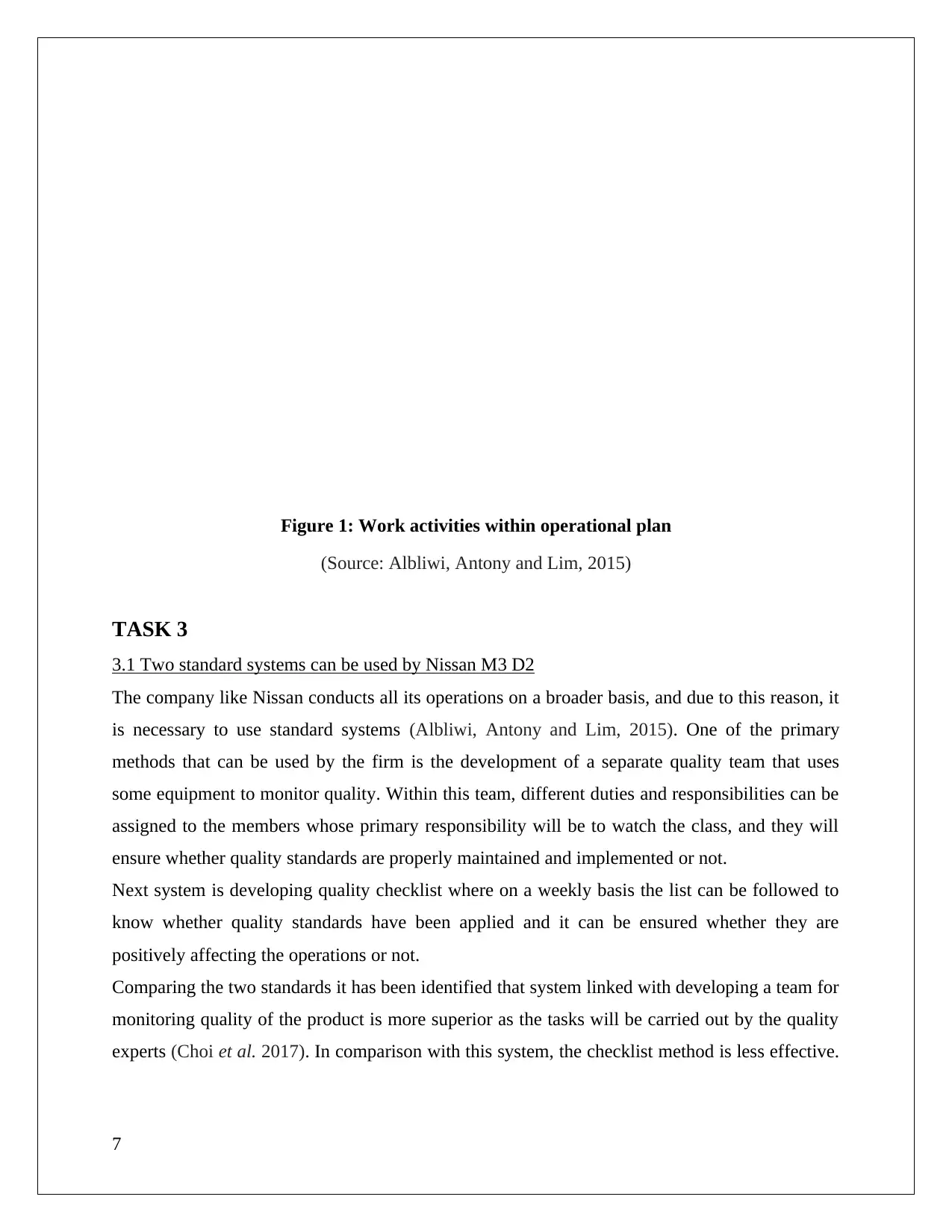
Figure 1: Work activities within operational plan
(Source: Albliwi, Antony and Lim, 2015)
TASK 3
3.1 Two standard systems can be used by Nissan M3 D2
The company like Nissan conducts all its operations on a broader basis, and due to this reason, it
is necessary to use standard systems (Albliwi, Antony and Lim, 2015). One of the primary
methods that can be used by the firm is the development of a separate quality team that uses
some equipment to monitor quality. Within this team, different duties and responsibilities can be
assigned to the members whose primary responsibility will be to watch the class, and they will
ensure whether quality standards are properly maintained and implemented or not.
Next system is developing quality checklist where on a weekly basis the list can be followed to
know whether quality standards have been applied and it can be ensured whether they are
positively affecting the operations or not.
Comparing the two standards it has been identified that system linked with developing a team for
monitoring quality of the product is more superior as the tasks will be carried out by the quality
experts (Choi et al. 2017). In comparison with this system, the checklist method is less effective.
7
(Source: Albliwi, Antony and Lim, 2015)
TASK 3
3.1 Two standard systems can be used by Nissan M3 D2
The company like Nissan conducts all its operations on a broader basis, and due to this reason, it
is necessary to use standard systems (Albliwi, Antony and Lim, 2015). One of the primary
methods that can be used by the firm is the development of a separate quality team that uses
some equipment to monitor quality. Within this team, different duties and responsibilities can be
assigned to the members whose primary responsibility will be to watch the class, and they will
ensure whether quality standards are properly maintained and implemented or not.
Next system is developing quality checklist where on a weekly basis the list can be followed to
know whether quality standards have been applied and it can be ensured whether they are
positively affecting the operations or not.
Comparing the two standards it has been identified that system linked with developing a team for
monitoring quality of the product is more superior as the tasks will be carried out by the quality
experts (Choi et al. 2017). In comparison with this system, the checklist method is less effective.
7
Paraphrase This Document
Need a fresh take? Get an instant paraphrase of this document with our AI Paraphraser
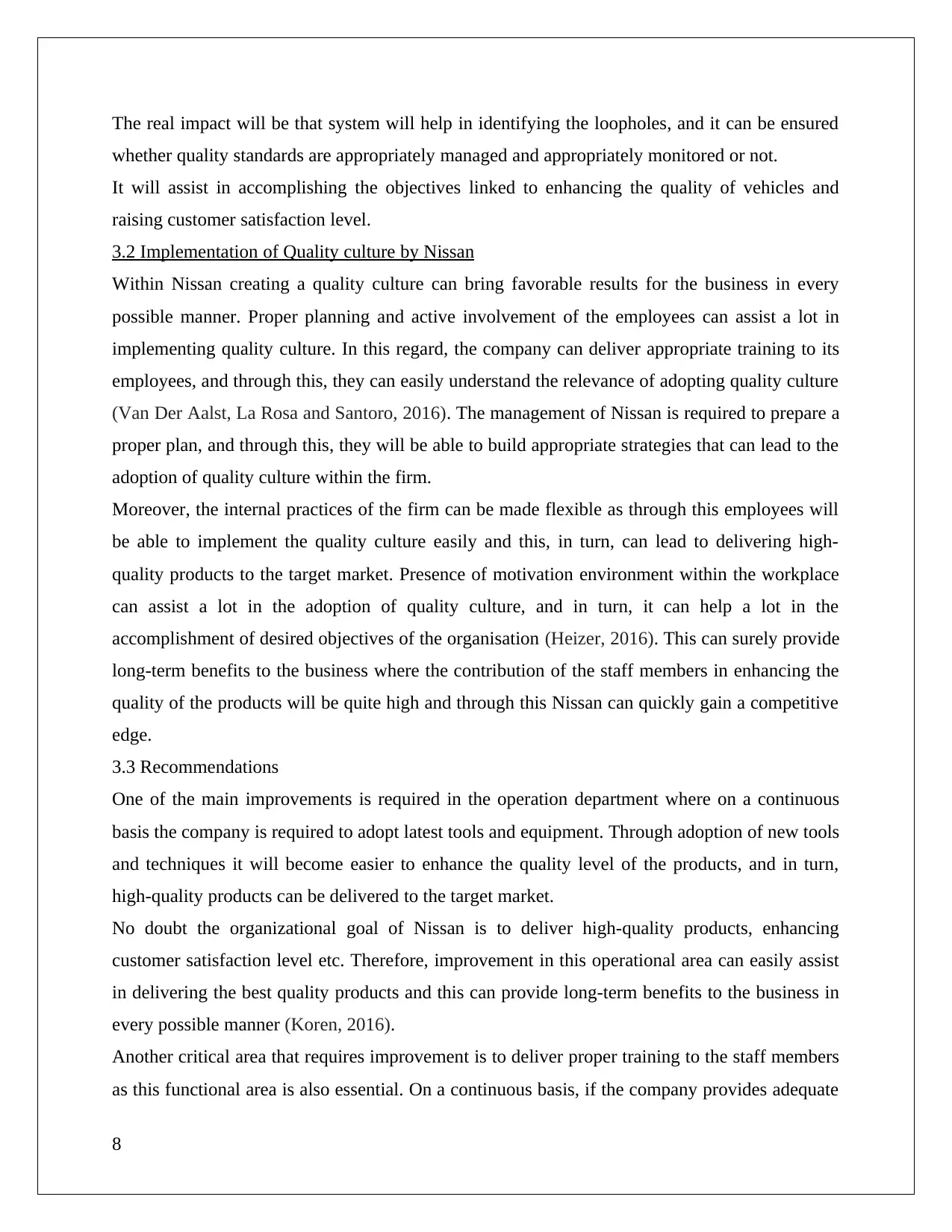
The real impact will be that system will help in identifying the loopholes, and it can be ensured
whether quality standards are appropriately managed and appropriately monitored or not.
It will assist in accomplishing the objectives linked to enhancing the quality of vehicles and
raising customer satisfaction level.
3.2 Implementation of Quality culture by Nissan
Within Nissan creating a quality culture can bring favorable results for the business in every
possible manner. Proper planning and active involvement of the employees can assist a lot in
implementing quality culture. In this regard, the company can deliver appropriate training to its
employees, and through this, they can easily understand the relevance of adopting quality culture
(Van Der Aalst, La Rosa and Santoro, 2016). The management of Nissan is required to prepare a
proper plan, and through this, they will be able to build appropriate strategies that can lead to the
adoption of quality culture within the firm.
Moreover, the internal practices of the firm can be made flexible as through this employees will
be able to implement the quality culture easily and this, in turn, can lead to delivering high-
quality products to the target market. Presence of motivation environment within the workplace
can assist a lot in the adoption of quality culture, and in turn, it can help a lot in the
accomplishment of desired objectives of the organisation (Heizer, 2016). This can surely provide
long-term benefits to the business where the contribution of the staff members in enhancing the
quality of the products will be quite high and through this Nissan can quickly gain a competitive
edge.
3.3 Recommendations
One of the main improvements is required in the operation department where on a continuous
basis the company is required to adopt latest tools and equipment. Through adoption of new tools
and techniques it will become easier to enhance the quality level of the products, and in turn,
high-quality products can be delivered to the target market.
No doubt the organizational goal of Nissan is to deliver high-quality products, enhancing
customer satisfaction level etc. Therefore, improvement in this operational area can easily assist
in delivering the best quality products and this can provide long-term benefits to the business in
every possible manner (Koren, 2016).
Another critical area that requires improvement is to deliver proper training to the staff members
as this functional area is also essential. On a continuous basis, if the company provides adequate
8
whether quality standards are appropriately managed and appropriately monitored or not.
It will assist in accomplishing the objectives linked to enhancing the quality of vehicles and
raising customer satisfaction level.
3.2 Implementation of Quality culture by Nissan
Within Nissan creating a quality culture can bring favorable results for the business in every
possible manner. Proper planning and active involvement of the employees can assist a lot in
implementing quality culture. In this regard, the company can deliver appropriate training to its
employees, and through this, they can easily understand the relevance of adopting quality culture
(Van Der Aalst, La Rosa and Santoro, 2016). The management of Nissan is required to prepare a
proper plan, and through this, they will be able to build appropriate strategies that can lead to the
adoption of quality culture within the firm.
Moreover, the internal practices of the firm can be made flexible as through this employees will
be able to implement the quality culture easily and this, in turn, can lead to delivering high-
quality products to the target market. Presence of motivation environment within the workplace
can assist a lot in the adoption of quality culture, and in turn, it can help a lot in the
accomplishment of desired objectives of the organisation (Heizer, 2016). This can surely provide
long-term benefits to the business where the contribution of the staff members in enhancing the
quality of the products will be quite high and through this Nissan can quickly gain a competitive
edge.
3.3 Recommendations
One of the main improvements is required in the operation department where on a continuous
basis the company is required to adopt latest tools and equipment. Through adoption of new tools
and techniques it will become easier to enhance the quality level of the products, and in turn,
high-quality products can be delivered to the target market.
No doubt the organizational goal of Nissan is to deliver high-quality products, enhancing
customer satisfaction level etc. Therefore, improvement in this operational area can easily assist
in delivering the best quality products and this can provide long-term benefits to the business in
every possible manner (Koren, 2016).
Another critical area that requires improvement is to deliver proper training to the staff members
as this functional area is also essential. On a continuous basis, if the company provides adequate
8
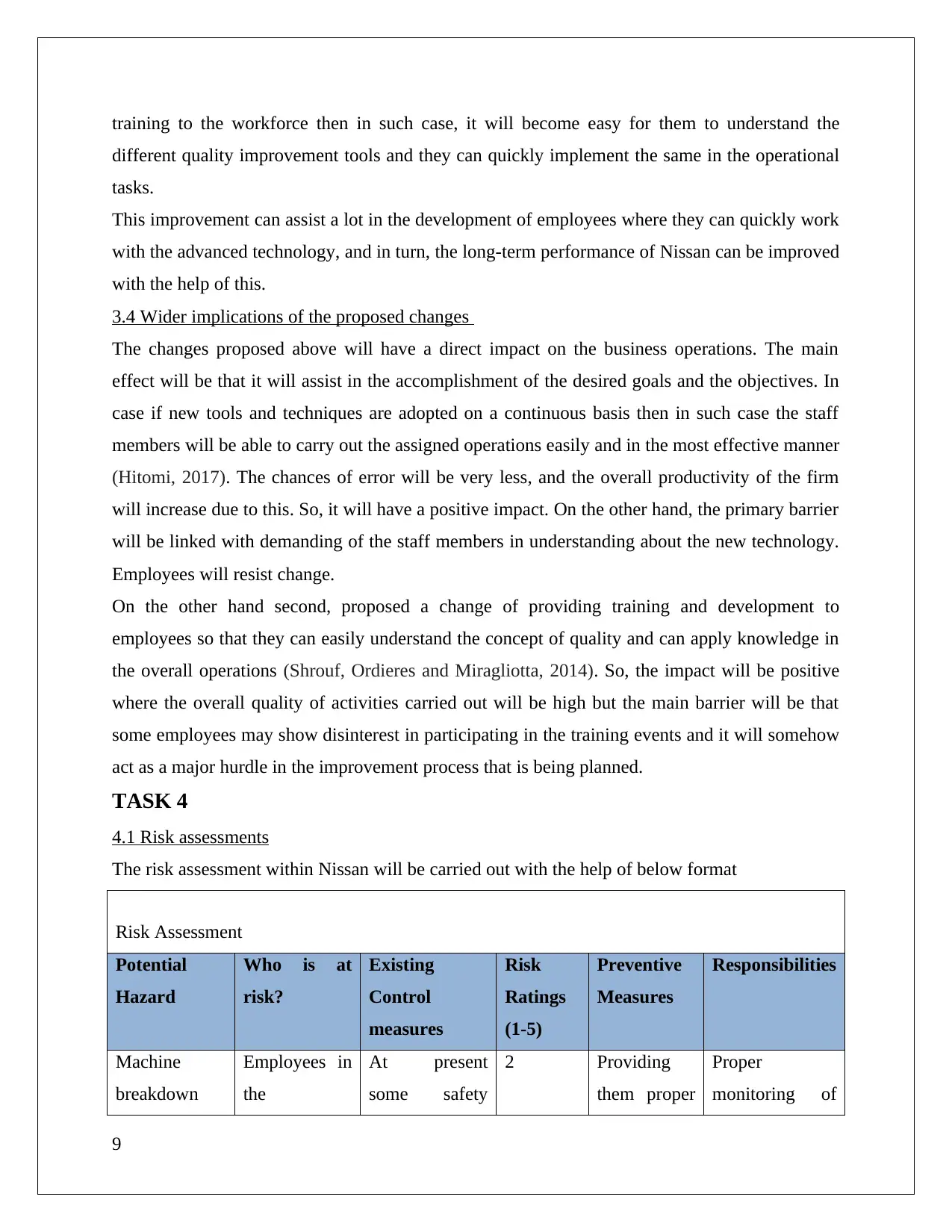
training to the workforce then in such case, it will become easy for them to understand the
different quality improvement tools and they can quickly implement the same in the operational
tasks.
This improvement can assist a lot in the development of employees where they can quickly work
with the advanced technology, and in turn, the long-term performance of Nissan can be improved
with the help of this.
3.4 Wider implications of the proposed changes
The changes proposed above will have a direct impact on the business operations. The main
effect will be that it will assist in the accomplishment of the desired goals and the objectives. In
case if new tools and techniques are adopted on a continuous basis then in such case the staff
members will be able to carry out the assigned operations easily and in the most effective manner
(Hitomi, 2017). The chances of error will be very less, and the overall productivity of the firm
will increase due to this. So, it will have a positive impact. On the other hand, the primary barrier
will be linked with demanding of the staff members in understanding about the new technology.
Employees will resist change.
On the other hand second, proposed a change of providing training and development to
employees so that they can easily understand the concept of quality and can apply knowledge in
the overall operations (Shrouf, Ordieres and Miragliotta, 2014). So, the impact will be positive
where the overall quality of activities carried out will be high but the main barrier will be that
some employees may show disinterest in participating in the training events and it will somehow
act as a major hurdle in the improvement process that is being planned.
TASK 4
4.1 Risk assessments
The risk assessment within Nissan will be carried out with the help of below format
Risk Assessment
Potential
Hazard
Who is at
risk?
Existing
Control
measures
Risk
Ratings
(1-5)
Preventive
Measures
Responsibilities
Machine
breakdown
Employees in
the
At present
some safety
2 Providing
them proper
Proper
monitoring of
9
different quality improvement tools and they can quickly implement the same in the operational
tasks.
This improvement can assist a lot in the development of employees where they can quickly work
with the advanced technology, and in turn, the long-term performance of Nissan can be improved
with the help of this.
3.4 Wider implications of the proposed changes
The changes proposed above will have a direct impact on the business operations. The main
effect will be that it will assist in the accomplishment of the desired goals and the objectives. In
case if new tools and techniques are adopted on a continuous basis then in such case the staff
members will be able to carry out the assigned operations easily and in the most effective manner
(Hitomi, 2017). The chances of error will be very less, and the overall productivity of the firm
will increase due to this. So, it will have a positive impact. On the other hand, the primary barrier
will be linked with demanding of the staff members in understanding about the new technology.
Employees will resist change.
On the other hand second, proposed a change of providing training and development to
employees so that they can easily understand the concept of quality and can apply knowledge in
the overall operations (Shrouf, Ordieres and Miragliotta, 2014). So, the impact will be positive
where the overall quality of activities carried out will be high but the main barrier will be that
some employees may show disinterest in participating in the training events and it will somehow
act as a major hurdle in the improvement process that is being planned.
TASK 4
4.1 Risk assessments
The risk assessment within Nissan will be carried out with the help of below format
Risk Assessment
Potential
Hazard
Who is at
risk?
Existing
Control
measures
Risk
Ratings
(1-5)
Preventive
Measures
Responsibilities
Machine
breakdown
Employees in
the
At present
some safety
2 Providing
them proper
Proper
monitoring of
9
⊘ This is a preview!⊘
Do you want full access?
Subscribe today to unlock all pages.

Trusted by 1+ million students worldwide
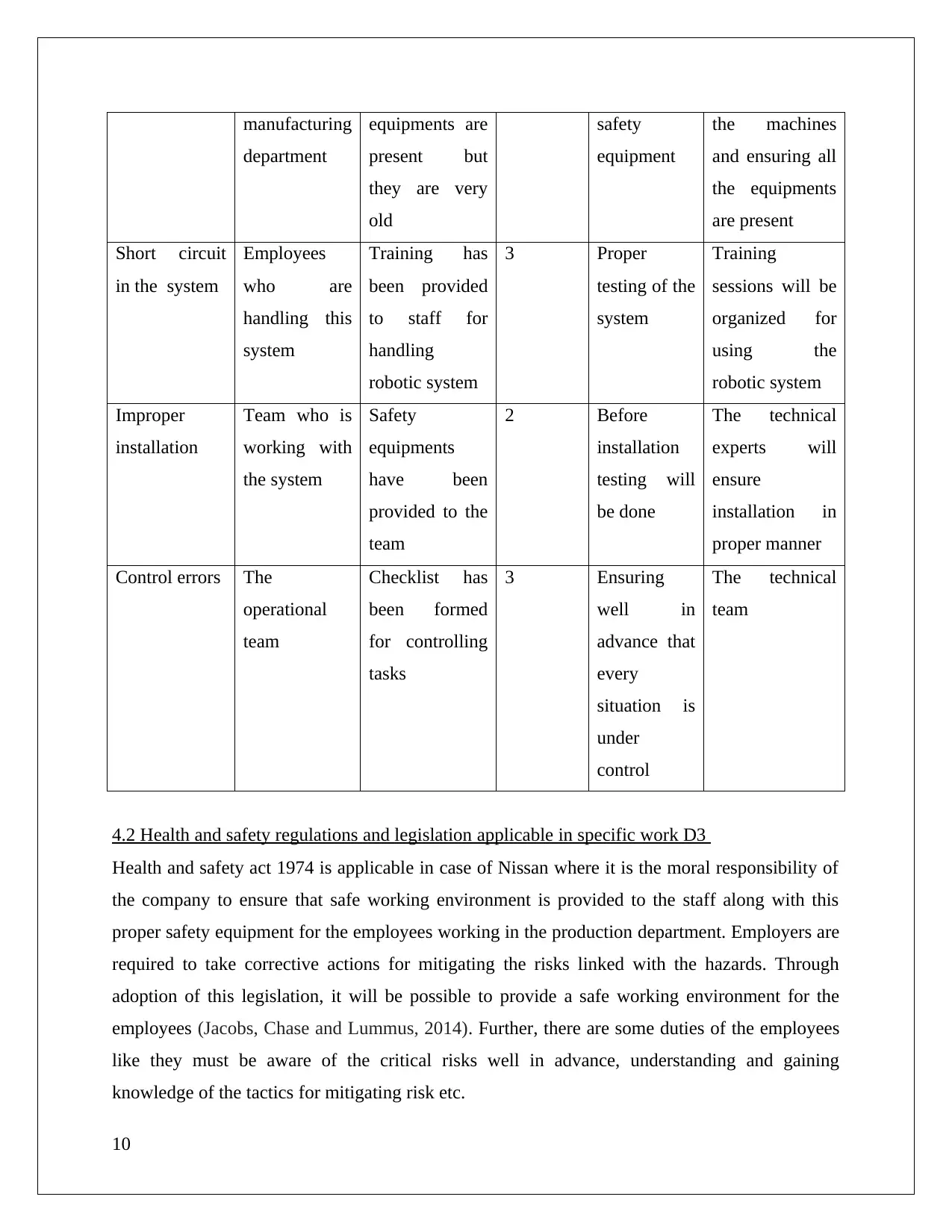
manufacturing
department
equipments are
present but
they are very
old
safety
equipment
the machines
and ensuring all
the equipments
are present
Short circuit
in the system
Employees
who are
handling this
system
Training has
been provided
to staff for
handling
robotic system
3 Proper
testing of the
system
Training
sessions will be
organized for
using the
robotic system
Improper
installation
Team who is
working with
the system
Safety
equipments
have been
provided to the
team
2 Before
installation
testing will
be done
The technical
experts will
ensure
installation in
proper manner
Control errors The
operational
team
Checklist has
been formed
for controlling
tasks
3 Ensuring
well in
advance that
every
situation is
under
control
The technical
team
4.2 Health and safety regulations and legislation applicable in specific work D3
Health and safety act 1974 is applicable in case of Nissan where it is the moral responsibility of
the company to ensure that safe working environment is provided to the staff along with this
proper safety equipment for the employees working in the production department. Employers are
required to take corrective actions for mitigating the risks linked with the hazards. Through
adoption of this legislation, it will be possible to provide a safe working environment for the
employees (Jacobs, Chase and Lummus, 2014). Further, there are some duties of the employees
like they must be aware of the critical risks well in advance, understanding and gaining
knowledge of the tactics for mitigating risk etc.
10
department
equipments are
present but
they are very
old
safety
equipment
the machines
and ensuring all
the equipments
are present
Short circuit
in the system
Employees
who are
handling this
system
Training has
been provided
to staff for
handling
robotic system
3 Proper
testing of the
system
Training
sessions will be
organized for
using the
robotic system
Improper
installation
Team who is
working with
the system
Safety
equipments
have been
provided to the
team
2 Before
installation
testing will
be done
The technical
experts will
ensure
installation in
proper manner
Control errors The
operational
team
Checklist has
been formed
for controlling
tasks
3 Ensuring
well in
advance that
every
situation is
under
control
The technical
team
4.2 Health and safety regulations and legislation applicable in specific work D3
Health and safety act 1974 is applicable in case of Nissan where it is the moral responsibility of
the company to ensure that safe working environment is provided to the staff along with this
proper safety equipment for the employees working in the production department. Employers are
required to take corrective actions for mitigating the risks linked with the hazards. Through
adoption of this legislation, it will be possible to provide a safe working environment for the
employees (Jacobs, Chase and Lummus, 2014). Further, there are some duties of the employees
like they must be aware of the critical risks well in advance, understanding and gaining
knowledge of the tactics for mitigating risk etc.
10
Paraphrase This Document
Need a fresh take? Get an instant paraphrase of this document with our AI Paraphraser
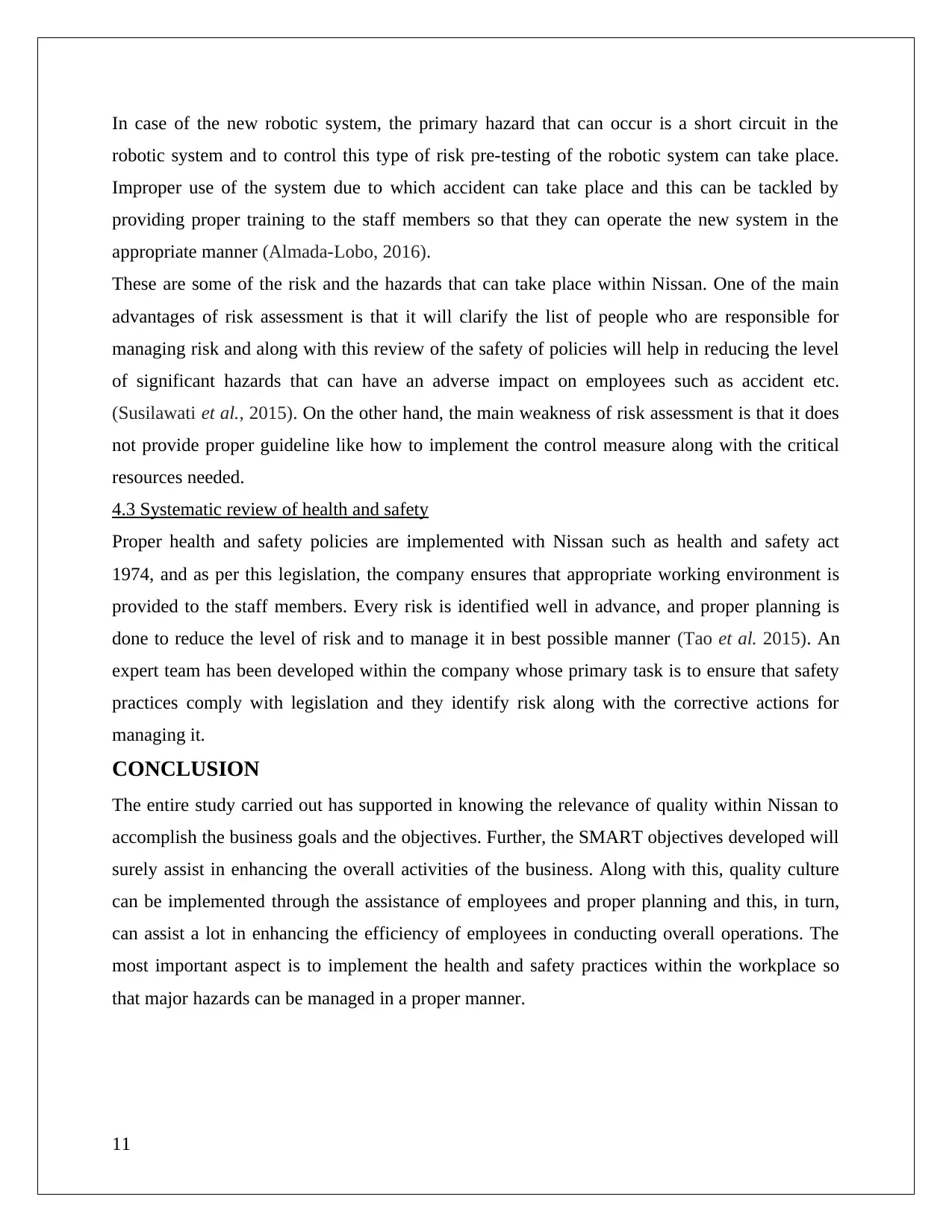
In case of the new robotic system, the primary hazard that can occur is a short circuit in the
robotic system and to control this type of risk pre-testing of the robotic system can take place.
Improper use of the system due to which accident can take place and this can be tackled by
providing proper training to the staff members so that they can operate the new system in the
appropriate manner (Almada-Lobo, 2016).
These are some of the risk and the hazards that can take place within Nissan. One of the main
advantages of risk assessment is that it will clarify the list of people who are responsible for
managing risk and along with this review of the safety of policies will help in reducing the level
of significant hazards that can have an adverse impact on employees such as accident etc.
(Susilawati et al., 2015). On the other hand, the main weakness of risk assessment is that it does
not provide proper guideline like how to implement the control measure along with the critical
resources needed.
4.3 Systematic review of health and safety
Proper health and safety policies are implemented with Nissan such as health and safety act
1974, and as per this legislation, the company ensures that appropriate working environment is
provided to the staff members. Every risk is identified well in advance, and proper planning is
done to reduce the level of risk and to manage it in best possible manner (Tao et al. 2015). An
expert team has been developed within the company whose primary task is to ensure that safety
practices comply with legislation and they identify risk along with the corrective actions for
managing it.
CONCLUSION
The entire study carried out has supported in knowing the relevance of quality within Nissan to
accomplish the business goals and the objectives. Further, the SMART objectives developed will
surely assist in enhancing the overall activities of the business. Along with this, quality culture
can be implemented through the assistance of employees and proper planning and this, in turn,
can assist a lot in enhancing the efficiency of employees in conducting overall operations. The
most important aspect is to implement the health and safety practices within the workplace so
that major hazards can be managed in a proper manner.
11
robotic system and to control this type of risk pre-testing of the robotic system can take place.
Improper use of the system due to which accident can take place and this can be tackled by
providing proper training to the staff members so that they can operate the new system in the
appropriate manner (Almada-Lobo, 2016).
These are some of the risk and the hazards that can take place within Nissan. One of the main
advantages of risk assessment is that it will clarify the list of people who are responsible for
managing risk and along with this review of the safety of policies will help in reducing the level
of significant hazards that can have an adverse impact on employees such as accident etc.
(Susilawati et al., 2015). On the other hand, the main weakness of risk assessment is that it does
not provide proper guideline like how to implement the control measure along with the critical
resources needed.
4.3 Systematic review of health and safety
Proper health and safety policies are implemented with Nissan such as health and safety act
1974, and as per this legislation, the company ensures that appropriate working environment is
provided to the staff members. Every risk is identified well in advance, and proper planning is
done to reduce the level of risk and to manage it in best possible manner (Tao et al. 2015). An
expert team has been developed within the company whose primary task is to ensure that safety
practices comply with legislation and they identify risk along with the corrective actions for
managing it.
CONCLUSION
The entire study carried out has supported in knowing the relevance of quality within Nissan to
accomplish the business goals and the objectives. Further, the SMART objectives developed will
surely assist in enhancing the overall activities of the business. Along with this, quality culture
can be implemented through the assistance of employees and proper planning and this, in turn,
can assist a lot in enhancing the efficiency of employees in conducting overall operations. The
most important aspect is to implement the health and safety practices within the workplace so
that major hazards can be managed in a proper manner.
11
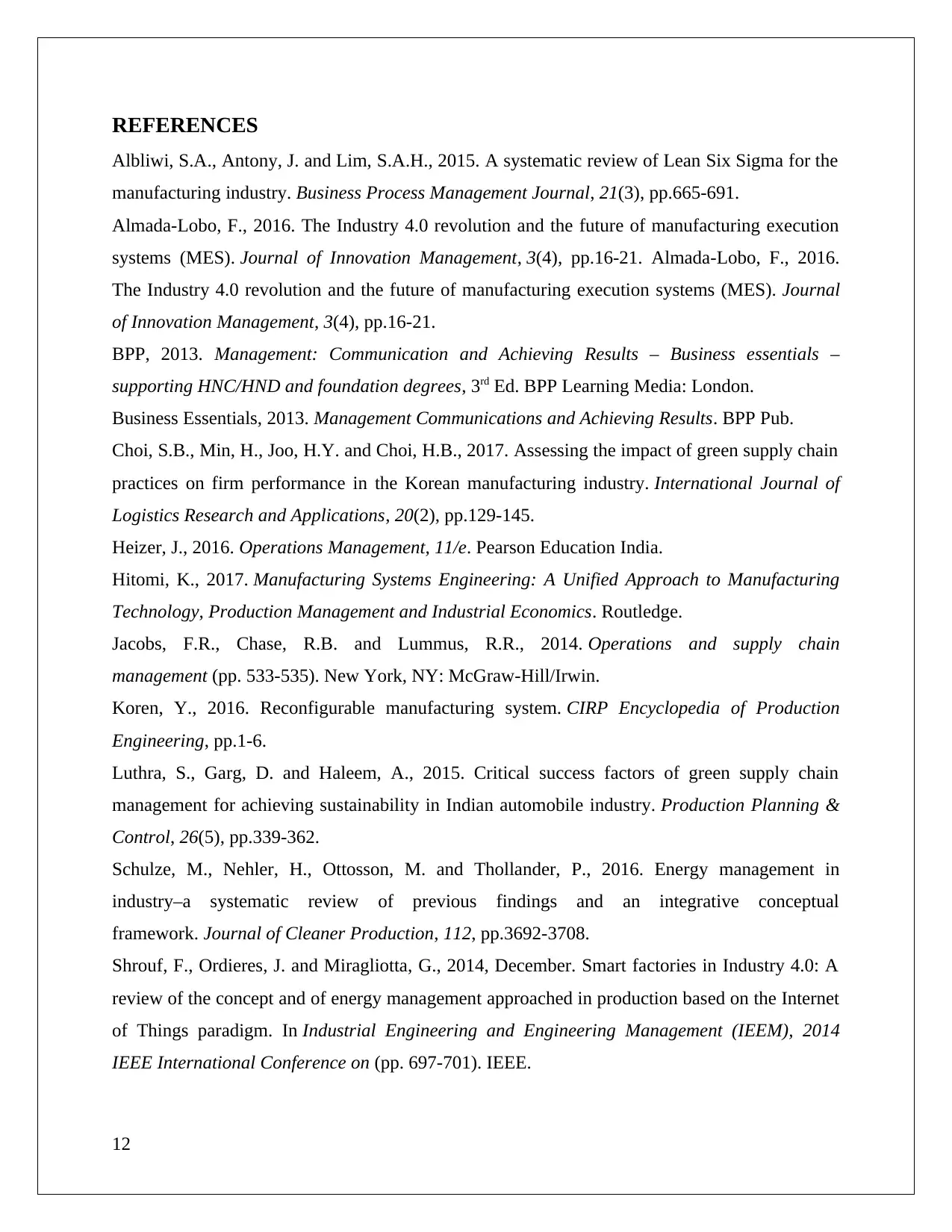
REFERENCES
Albliwi, S.A., Antony, J. and Lim, S.A.H., 2015. A systematic review of Lean Six Sigma for the
manufacturing industry. Business Process Management Journal, 21(3), pp.665-691.
Almada-Lobo, F., 2016. The Industry 4.0 revolution and the future of manufacturing execution
systems (MES). Journal of Innovation Management, 3(4), pp.16-21. Almada-Lobo, F., 2016.
The Industry 4.0 revolution and the future of manufacturing execution systems (MES). Journal
of Innovation Management, 3(4), pp.16-21.
BPP, 2013. Management: Communication and Achieving Results – Business essentials –
supporting HNC/HND and foundation degrees, 3rd Ed. BPP Learning Media: London.
Business Essentials, 2013. Management Communications and Achieving Results. BPP Pub.
Choi, S.B., Min, H., Joo, H.Y. and Choi, H.B., 2017. Assessing the impact of green supply chain
practices on firm performance in the Korean manufacturing industry. International Journal of
Logistics Research and Applications, 20(2), pp.129-145.
Heizer, J., 2016. Operations Management, 11/e. Pearson Education India.
Hitomi, K., 2017. Manufacturing Systems Engineering: A Unified Approach to Manufacturing
Technology, Production Management and Industrial Economics. Routledge.
Jacobs, F.R., Chase, R.B. and Lummus, R.R., 2014. Operations and supply chain
management (pp. 533-535). New York, NY: McGraw-Hill/Irwin.
Koren, Y., 2016. Reconfigurable manufacturing system. CIRP Encyclopedia of Production
Engineering, pp.1-6.
Luthra, S., Garg, D. and Haleem, A., 2015. Critical success factors of green supply chain
management for achieving sustainability in Indian automobile industry. Production Planning &
Control, 26(5), pp.339-362.
Schulze, M., Nehler, H., Ottosson, M. and Thollander, P., 2016. Energy management in
industry–a systematic review of previous findings and an integrative conceptual
framework. Journal of Cleaner Production, 112, pp.3692-3708.
Shrouf, F., Ordieres, J. and Miragliotta, G., 2014, December. Smart factories in Industry 4.0: A
review of the concept and of energy management approached in production based on the Internet
of Things paradigm. In Industrial Engineering and Engineering Management (IEEM), 2014
IEEE International Conference on (pp. 697-701). IEEE.
12
Albliwi, S.A., Antony, J. and Lim, S.A.H., 2015. A systematic review of Lean Six Sigma for the
manufacturing industry. Business Process Management Journal, 21(3), pp.665-691.
Almada-Lobo, F., 2016. The Industry 4.0 revolution and the future of manufacturing execution
systems (MES). Journal of Innovation Management, 3(4), pp.16-21. Almada-Lobo, F., 2016.
The Industry 4.0 revolution and the future of manufacturing execution systems (MES). Journal
of Innovation Management, 3(4), pp.16-21.
BPP, 2013. Management: Communication and Achieving Results – Business essentials –
supporting HNC/HND and foundation degrees, 3rd Ed. BPP Learning Media: London.
Business Essentials, 2013. Management Communications and Achieving Results. BPP Pub.
Choi, S.B., Min, H., Joo, H.Y. and Choi, H.B., 2017. Assessing the impact of green supply chain
practices on firm performance in the Korean manufacturing industry. International Journal of
Logistics Research and Applications, 20(2), pp.129-145.
Heizer, J., 2016. Operations Management, 11/e. Pearson Education India.
Hitomi, K., 2017. Manufacturing Systems Engineering: A Unified Approach to Manufacturing
Technology, Production Management and Industrial Economics. Routledge.
Jacobs, F.R., Chase, R.B. and Lummus, R.R., 2014. Operations and supply chain
management (pp. 533-535). New York, NY: McGraw-Hill/Irwin.
Koren, Y., 2016. Reconfigurable manufacturing system. CIRP Encyclopedia of Production
Engineering, pp.1-6.
Luthra, S., Garg, D. and Haleem, A., 2015. Critical success factors of green supply chain
management for achieving sustainability in Indian automobile industry. Production Planning &
Control, 26(5), pp.339-362.
Schulze, M., Nehler, H., Ottosson, M. and Thollander, P., 2016. Energy management in
industry–a systematic review of previous findings and an integrative conceptual
framework. Journal of Cleaner Production, 112, pp.3692-3708.
Shrouf, F., Ordieres, J. and Miragliotta, G., 2014, December. Smart factories in Industry 4.0: A
review of the concept and of energy management approached in production based on the Internet
of Things paradigm. In Industrial Engineering and Engineering Management (IEEM), 2014
IEEE International Conference on (pp. 697-701). IEEE.
12
⊘ This is a preview!⊘
Do you want full access?
Subscribe today to unlock all pages.

Trusted by 1+ million students worldwide
1 out of 13
Related Documents
Your All-in-One AI-Powered Toolkit for Academic Success.
+13062052269
info@desklib.com
Available 24*7 on WhatsApp / Email
![[object Object]](/_next/static/media/star-bottom.7253800d.svg)
Unlock your academic potential
Copyright © 2020–2025 A2Z Services. All Rights Reserved. Developed and managed by ZUCOL.





